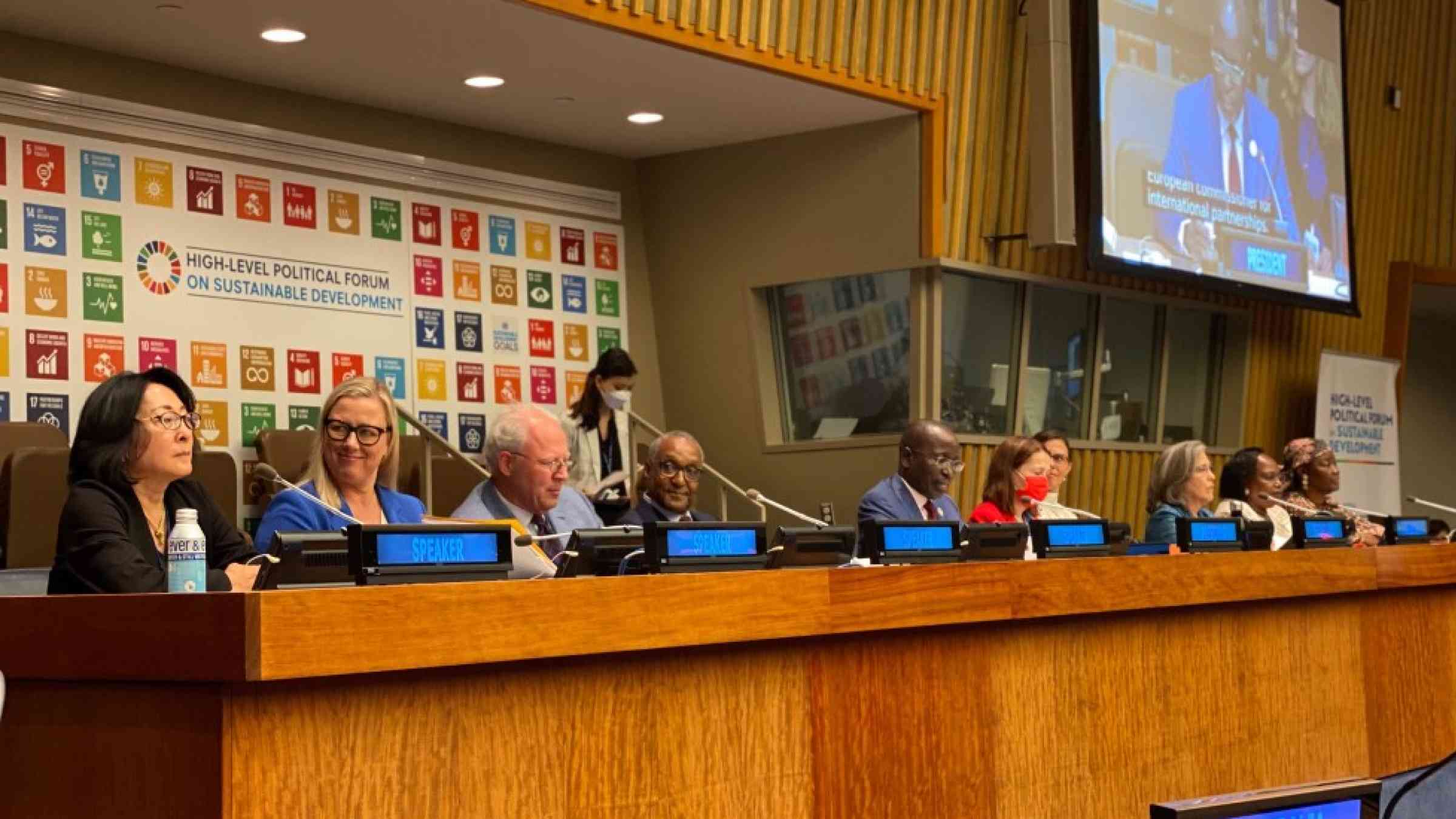HLPF 2022: crises and regressions on SDGs demonstrate need for risk-informed development

Discussions at the United Nations High-Level Political Forum (HLPF) 2022, held between 5 – 15 July at the UN Headquarters in New York, highlight the need for disaster risk reduction as an enabler and protector of the Sustainable Development Goals (SDGs), especially as both 2030 Agenda and the Sendai Framework for Disaster Risk Reduction enter their midpoint in 2023.
Held under the theme of “Building back better from the coronavirus disease (COVID-19) while advancing the full implementation of the 2030 Agenda for Sustainable Development,” the first in-person HLPF since the onset of the pandemic conveyed a sense of urgency that accelerated action is needed to rescue the 2030 Agenda, including through the integration of disaster risk reduction into development.
This was reflected in the HLPF’s adoption of a Ministerial Declaration which recognized that “the development and implementation of risk-informed plans, policies, programmes and investments are essential for sustainable development and the achievement of the Sustainable Development Goals.”
As progress on the SDGs has already been severely derailed by the pandemic and the climate crisis, countries cannot afford to lose any more ground to disasters.
“The world faces cascading crises that are causing profound suffering today, and carry the seeds of dangerous inequality, instability and climate chaos tomorrow,” said Mr. António Guterres, UN Secretary-General, who spoke at the opening of the Ministerial Segment of HLPF and called for “investment in long-term resilience over short-term profit.”
The call for investing in building resilience was carried throughout the Forum by the United Nations Office for Disaster Risk Reduction (UNDRR) along with senior UN officials, national government representatives and civil society organizations.
“When you look at the main issues that are stifling progress on the SDGs, namely the pandemic, climate breakdown, and growing humanitarian needs from crises and disasters, it is clear that disaster risk reduction, with its focus on understanding and mitigating overlapping risks, is critical to the achievement of the SDGs,” said Ms. Mami Mizutori, Special Representative of the Secretary-General for Disaster Risk Reduction, and head of UNDRR, speaking at a formal session on “Working towards the 2023 SDG Summit.”
The September 2023 SDG Summit will mark the midterm review of the SDGs, which will occur four months after midterm review of the implementation of the Sendai Framework.
This timing presents an opportunity to advance the integration of disaster risk reduction into development by ensuring that future deliberations around accelerating progress on the SDGs benefit from the outcomes of the midterm review of the implementation of the Sendai Framework, including lessons learned brought forward.
“As we look toward the midterm review of the Sendai framework at the General Assembly, let us seize the opportunity to renew commitment to implementation and to fortify our development efforts with a risk-informed, resilience-driven approach,” said Mr. Abdulla Shahid, President of the General Assembly, who spoke at a UNDRR side event.

The side event, organized by UNDRR and co-sponsored by the Permanent Missions of Indonesia, Australia, Jamaica, Kenya, Morocco, and Portugal, provided delegates with a summary of the key outcomes and recommendations of the regional and global platforms on disaster risk reduction, apart from the Asia-Pacific region, where the Asia-Pacific Ministerial Conference on Disaster Risk Reduction will be hosted by Australia in September 2022.
“2023 must be a game changer for how we manage disaster risk. There is a clear path from the global platform to the midterm review of the Sendai Framework and its high-level meeting at the General Assembly in May 2023, the SDG Summit and the Summit of the Future in September next year,” said Ms. Natalie Cohen, a representative of Australia’s Department of Foreign Affairs and Trade, who spoke on behalf of the Permanent Missions of Australia, Indonesia, Norway, and Peru as Co-Chairs of the Group of Friends of Disaster Risk Reduction.
As an opportunity to promote policy coherence and highlight the synergies between the implementation of the Sendai Framework and the 2030 Agenda, UNDRR also organized a Voluntary National Review (VNR) Lab for Member States.
The VNR Lab featured examples from Dominica, Malawi, and Switzerland, demonstrating how the voluntary national reports for the Midterm Review of the implementation of the Sendai Framework can be integrated into and inform the SDG-focused VNRs and vice-versa
“An integrated risk management approach should be taken into account for sustainable development. Therefore, the merging of the Sendai Framework and the SDGs is important for us and we will prepare a written review which I hope will have important learnings for us and the broader public,” said Ms. Regina Gujan, Deputy Director of the Multilateral Humanitarian Affairs Division at the Swiss Agency for Development and Cooperation.

The HLPF 2022 concluded with the adoption of a Ministerial Declaration of the high-level segment of the 2022 session of the Economic and Social Council and the HLPF.
Among its calls to action, the declaration encourages Member States to adopt a “multi-hazard, whole-of-government, whole-of-society and coordinated approach to prevention and risk reduction” and called for “ambitious and action-oriented outcomes” at the midterm review of the Sendai Framework.
Engaging in the midterm review can provide governments and stakeholders with a full and honest accounting of progress to date on its implementation, which can generate the insights and recommendations needed to close the resilience gap and accelerate progress on the SDGs.
“The Midterm Review of the Sendai Framework is an extremely timely moment to take stock of global progress in reducing disaster risk. Its deliberations and political declaration will provide valuable insight to the SDG summit on how to make meaningful progress on reducing risk and building resilience by 2030. Our prosperity and that of future generations depend on it,” said Ms. Mizutori.
For more information on how to engage in the Midterm Review, visit here.